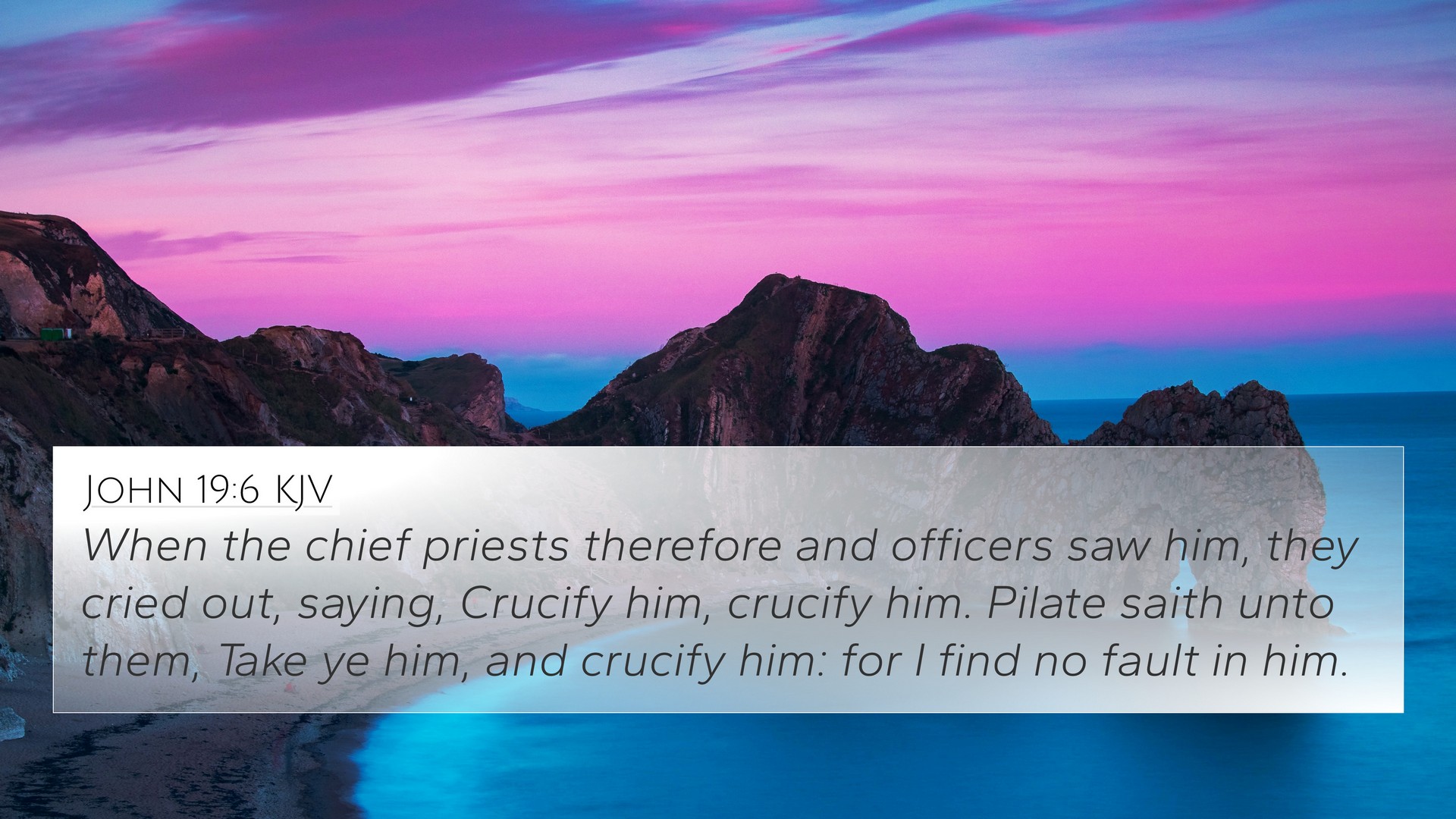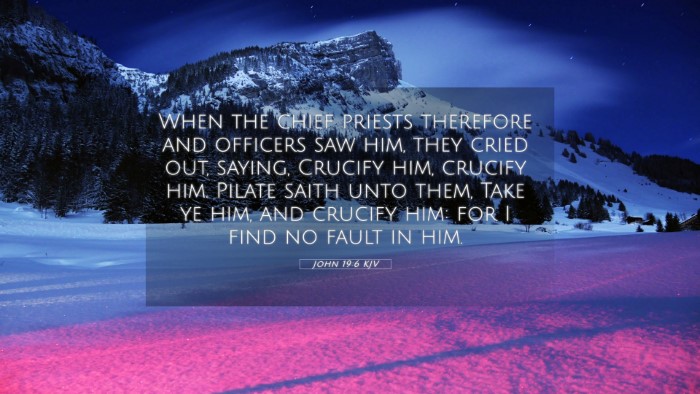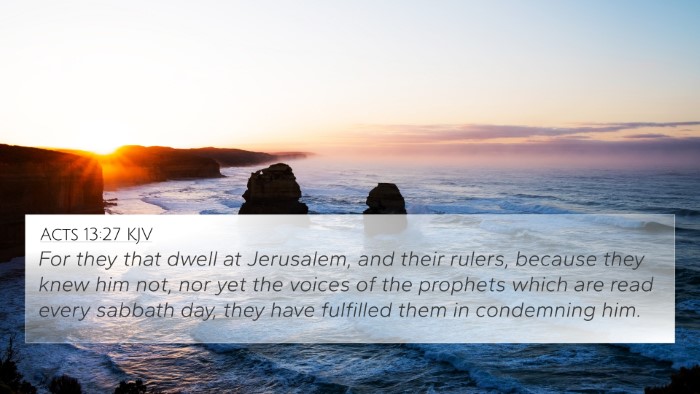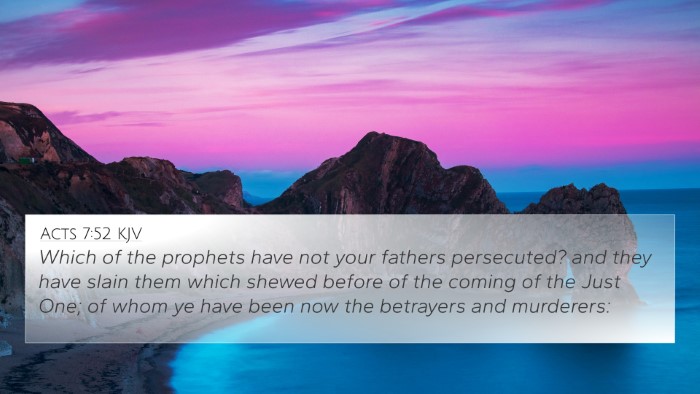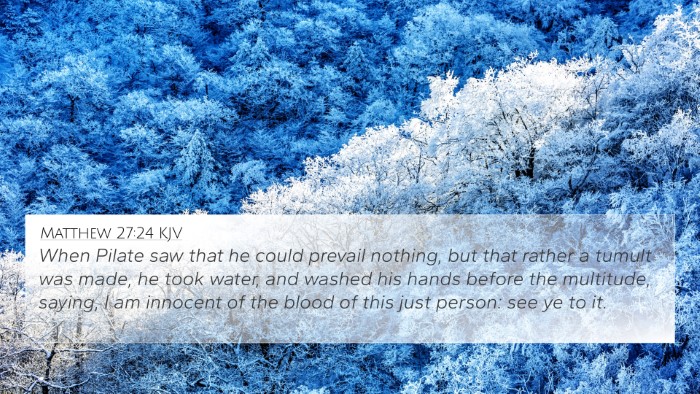Understanding John 19:6
Verse Context: John 19:6 states, "When the chief priests therefore and officers saw him, they cried out, saying, Crucify him, crucify him. Pilate saith unto them, Take ye him, and crucify him: for I find no fault in him." This moment captures the intense pressures faced by Pontius Pilate during the trial of Jesus Christ and the fervent demand from the Jewish authorities for His crucifixion.
General Meaning: This verse illustrates the culmination of animosity towards Jesus, showing the stark contrast between Roman law and the desires of the Jewish leaders. It reflects the profound injustice present in the Passion narrative, where an innocent man faces death driven by external political and religious pressures.
Commentary Insights
Matthew Henry's Commentary
Henry emphasizes the shameful behavior of the religious leaders, noting their hypocrisy in calling for the execution of a man who had committed no crime. He highlights the depth of their hatred for Jesus, which led to this extreme demand. Pilate’s reluctance to condemn an innocent man illustrates the moral struggle faced by authorities caught between public pressure and justice.
Albert Barnes' Commentary
Barnes discusses the significance of Pilate's statement about finding no fault in Jesus, asserting that it serves as a testament to Jesus's righteousness. He interprets the fervor of the crowd as indicative of the persecution faced by true followers of Christ throughout history. Furthermore, he links this moment to prophetic texts, suggesting it fulfills Old Testament prophecies regarding the suffering servant.
Adam Clarke's Commentary
Clarke focuses on the chilling cry of “Crucify him!” and its implications, offering insights into the social and political motivations behind the crowd's demand. He posits that this verse reveals the transference of guilt from the Jewish leaders to the Roman authorities, culminating in a profound irony where the judge becomes indistinguishable from the condemned. Clarke also suggests this moment starkly contrasts the principles of justice and mercy embodied by Jesus.
Cross-References to John 19:6
- Matthew 27:23-24: Pilate expresses his awareness of Jesus's innocence and attempts to absolve himself of responsibility.
- Luke 23:4: Pilate boldly declares he finds no guilt in Jesus, similar to his stance in John 19:6.
- Isaiah 53:3: This passage prophesies the rejection and suffering of the Messiah, connecting to the crowd's demand for crucifixion.
- Acts 3:14-15: Peter addresses the Jewish crowd about their role in the crucifixion of Jesus, reflecting the fulfillment of this moment.
- John 18:38: Pilate again states he finds no fault in Jesus, reinforcing the juxtaposition between truth and the crowd's cries.
- Hebrews 10:29: This passage discusses the severity of rejecting the Son of God, echoing the ancient tension in John 19:6.
- Psalm 22:16: Foretelling the piercing of Jesus's hands and feet, it connects with the evil intentions surrounding His crucifixion.
Thematic Connections
John 19:6 exemplifies key themes present throughout Scripture, including:
- Innocence and Condemnation: The unjust trial of Jesus emphasizes the theme of innocence being punished.
- Public vs. Private Justice: Pilate's internal conflict and public pressure highlight the challenges of administering true justice.
- Fulfillment of Prophecy: The demand for crucifixion mirrors prophetic utterances regarding the Messiah’s suffering.
- Human Sinfulness: The verse displays the collective sin of humanity calling for violence against the innocent.
Tools for Bible Cross-Referencing
For those seeking deeper insights into biblical connections, consider utilizing:
- Bible Concordance: A valuable tool for finding themes and topics across scripture.
- Cross-reference Bible study guides: These resources can help readers link related scripture for comparative analysis.
- Comprehensive Bible cross-reference materials: To help in identifying connections between Old and New Testament narratives.
Conclusion
John 19:6 not only captures a critical moment in the narrative of Christ's passion but also serves as a pivotal reference point for understanding the dynamics of sin, justice, and prophecy in the larger context of scripture. Engaging in comparative Bible verse analysis through referencing similar texts enhances our understanding and application of biblical truths in our lives today.
